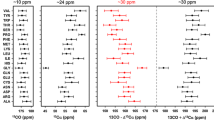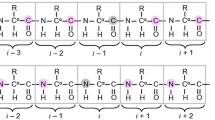Abstract
We present reduced dimensionality (RD) 3D HN(CA)NH for efficient sequential assignment in proteins. The experiment correlates the 15N and 1H chemical shift of a residue (‘i’) with those of its immediate N-terminal (i − 1) and C-terminal (i + 1) neighbors and provides four-dimensional chemical shift correlations rapidly with high resolution. An assignment strategy is presented which combines the correlations observed in this experiment with amino acid type information obtained from 3D CBCA(CO)NH. By classifying the 20 amino acid types into seven distinct categories based on 13Cβ chemical shifts, it is observed that a stretch of five sequentially connected residues is sufficient to map uniquely on to the polypeptide for sequence specific resonance assignments. This method is exemplified by application to three different systems: maltose binding protein (42 kDa), intrinsically disordered domain of insulin-like growth factor binding protein-2 and Ubiquitin. Fast data acquisition is demonstrated using longitudinal 1H relaxation optimization. Overall, 3D HN(CA)NH is a powerful tool for high throughput resonance assignment, in particular for unfolded or intrinsically disordered polypeptides.








Similar content being viewed by others
References
Atreya HS, Chary KVR (2002) Automated NMR assignments of proteins for high throughput structure determination: TATAPRO II. Curr Sci 83:1372–1376
Atreya HS, Szyperski T (2004) G-matrix Fourier transform NMR spectroscopy for complete protein resonance assignment. Proc Natl Acad Sci 101:9642–9647
Atreya HS, Szyperski T (2005) Rapid NMR data collection. Methods Enzymol 394:78–108
Atreya HS, Sahu SC, Chary KVR, Govil G (2000) A tracked approach for automated NMR assignments in proteins (TATAPRO). J Biomol NMR 17:125–136
Baran MC, Huang YJ, Moseley HNB, Montelione GT (2004) Automated analysis of protein NMR assignments and structures. Chem Rev 104:3541–3555
Bartels C, Xia TH, Billeter M, Güntert P, Wüthrich K (1995) The program XEASY for computer-supported Nmr spectral-analysis of biological macromolecules. J Biomol NMR 6:1–10
Bracken C, Palmer AG, Cavanagh J (1997) (H)N(COCA)NH and HN(COCA)NH experiments for 1H–15N backbone assignments in C-13/N-15-labeled proteins. J Biomol NMR 9:94–100
Cavanagh J, Fairbrother WJ, Palmer AG, Rance M, Skelton NJ (2007) Protein NMR spectroscopy. Academic Press, San Diego
Delaglio F, Grzesiek S, Vuister GW, Zhu G, Pfeifer J, Bax A (1995) NMRPIPE—a multidimensional spectral processing system based on Unix pipes. J Biomol NMR 6:277–293
Diercks T, Daniels M, Kaptein R (2005) Extended flip-back schemes for sensitivity enhancement in multidimensional HSQC-type out-and-back experiments. J Biomol NMR 33:243–259
Dyson HJ, Wright PE (2005) Intrinsically unstructured proteins and their functions. Nat Rev Mol Cell Biol 6:197–208
Fiorito F, Hiller S, Wider G, Wüthrich K (2006) Automated resonance assignment of proteins: 6D APSY-NMR. J Biomol NMR 35:27–37
Frueh DP, Sun ZY, Vosburg DA, Walsh CT, Hoch JC, Wagner G (2006) Non-uniformly sampled double-TROSY hNcaNH experiments for NMR sequential assignments of large proteins. J Am Chem Soc 128:5757–5763
Frueh DP, Arthanari H, Koglin A, Walsh CT, Wagner G (2009) A double TROSY hNCAnH experiment for efficient assignment of large and challenging proteins. J Am Chem Soc 131:12880–12881
Hiller S, Wasmer C, Wider G, Wüthrich K (2007) Sequence-specific resonance assignment of soluble nonglobular proteins by 7D APSY-NMR spectroscopy. J Am Chem Soc 129:10823–10828
Ikegami T, Sato S, Walchli M, Kyogoku Y, Shirakawa M (1997) An efficient HN(CA)NH pulse scheme for triple-resonance 4D correlation of sequential amide protons and nitrogens-15 in deuterated proteins. J Magn Reson 124:214–217
Kim S, Szyperski T (2003) GFT NMR, a new approach to rapidly obtain precise high-dimensional NMR spectral information. J Am Chem Soc 125:1385–1393
Krishnarjuna B, Jaipuria G, Thakur A, D’Silva P, Atreya HS (2011) Amino acid selective unlabeling for sequence specific resonance assignments in proteins. J Biomol NMR 49:39–51
Liu GH, Shen Y, Atreya HS, Parish D, Shao Y, Sukumaran DK, Xiao R, Yee A, Lemak A, Bhattacharya A, Acton TA, Arrowsmith CH, Montelione GT, Szyperski T (2005) NMR data collection and analysis protocol for high-throughput protein structure determination. Proc Natl Acad Sci 102:10487–10492
Ohki SY, Kainosho M (2008) Stable isotope labeling methods for protein NMR spectroscopy. Prog Nucl Magn Reson Spectrosc 53:208–226
Panchal SC, Bhavesh NS, Hosur RV (2001) Improved 3D triple resonance experiments, HNN and HN(C)N, for H–N and N-15 sequential correlations in (C-13, N-15) labeled proteins: Application to unfolded proteins. J Biomol NMR 20:135–147
Pervushin K, Vogeli B, Eletsky A (2002) Longitudinal 1H relaxation optimization in TROSY NMR spectroscopy. J Am Chem Soc 124:12898–12902
Shirakawa M, Walchli M, Shimizu M, Kyogoku Y (1995) The use of heteronuclear cross-polarisation for backbone assignment of H-2-labeled, N-15-labeled and C-13-labeled proteins—a pulse scheme for triple-resonance 4D correlation of sequential amide protons and N-15. J Biomol NMR 5:323–326
Swain M, Slomiany MG, Rosenzweig SA, Atreya HS (2010) High-yield bacterial expression and structural characterization of recombinant human insulin-like growth factor binding protein-2. Arch Biochem Biophys 501:195–200
Szyperski T, Atreya HS (2006) Principles and applications of GFT projection NMR spectroscopy. Magn Reson Chem 44:S51–S60
Szyperski T, Braun D, Fernandez C, Bartels C, Wüthrich K (1995) A novel reduced-dimensionality triple resonance experiment for efficient polypeptide backbone assignment, 3D COHNNCA. J Magn Reson B108:197–203
Szyperski T, Braun D, Banecki B, Wüthrich K (1996) Useful information from axial peak magnetization in projected NMR experiments. J Am Chem Soc 118:8146–8147
Szyperski T, Yeh DC, Sukumaran DK, Moseley HNB, Montelione GT (2002) Reduced-dimensionality NMR spectroscopy for high-throughput protein resonance assignment. Proc Natl Acad Sci 99:8009–8014
Takeuchi K, Gal M, Takahashi H, Shimada I, Wagner G (2011) HNCA-TOCSY-CANH experiments with alternate (13)C-(12)C labeling: a set of 3D experiment with unique supra-sequential information for mainchain resonance assignment. J Biomol NMR 49:17–26
Tugarinov V, Hwang PM, Kay LE (2004) Nuclear magnetic resonance spectroscopy of high-molecular-weight proteins. Ann Rev Biochem 73:107–146
Weisemann R, Rüterjans H, Bermel W (1993) 3D triple-resonance NMR techniques for the sequential assignment of NH and N-15 resonances in N-15-labeled and C-13-labeled proteins. J Biomol NMR 3:113–120
Acknowledgments
The facilities provided by NMR Research Centre at IISc and National facility for high-field NMR at Tata Institute of Fundamental Research (TIFR; Mumbai) supported by Department of Science and Technology (DST), India is gratefully acknowledged. HSA acknowledges support from DST-SERC and Department of Biotechnology (DBT) research awards. GJ acknowledges fellowship from Council of Scientific and Industrial Research (CSIR), India. We thank Dr. John Cort, Pacific Northwest National Laboratory, for providing the Ubiquitin plasmid and Prof. R. V. Hosur, TIFR for providing the MBP sample.
Author information
Authors and Affiliations
Corresponding author
Electronic supplementary material
Below is the link to the electronic supplementary material.
Rights and permissions
About this article
Cite this article
Chandra, K., Jaipuria, G., Shet, D. et al. Efficient sequential assignments in proteins with reduced dimensionality 3D HN(CA)NH. J Biomol NMR 52, 115–126 (2012). https://doi.org/10.1007/s10858-011-9598-x
Received:
Accepted:
Published:
Issue Date:
DOI: https://doi.org/10.1007/s10858-011-9598-x




